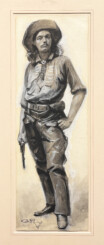Russell, Charles
Born in St. Louis in 1864 just as the Civil War was coming to a close, young Charlie Russell’s hometown was the gateway to the West, the borderland between “civilization” and the rapidly filling “frontier.” Russell saw people and horses lighting out for the open range and their stories enthralled him. At the same time, his mother’s skill at painting flowers planted the seed that would become a vocation. In his teens, Russell convinced his parents to allow him to head West and try his hand at punching cows. He did so, making a go of it even as he made fast friends among the characters of the Montana Territory’s Judith Basin. Soon, he began to capture cowboy life in art, in watercolor at first, then in oil, and, lastly, in bronze. Russell’s work was being published regularly in Harper’s Weekly and had been acclaimed as original, fresh and real even before he married Nancy Cooper in 1896. Nancy took responsibility for the business end of Russell’s art and proved to be a tough, shrewd agent for her husband. Russell’s devotion, not only to his West, but to what he called “The West that has passed” led to some of Western art’s most celebrated and prized works in oil, watercolor, and bronze.

